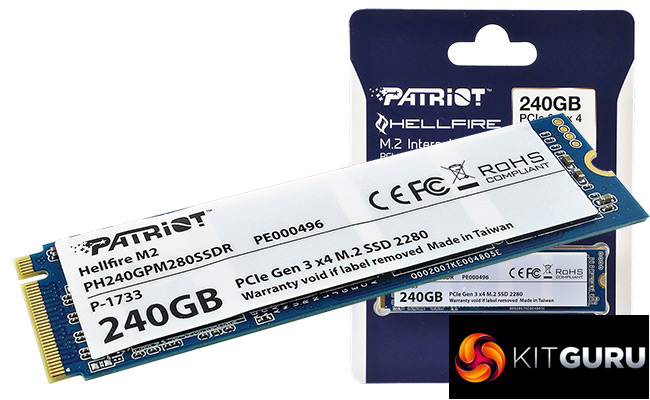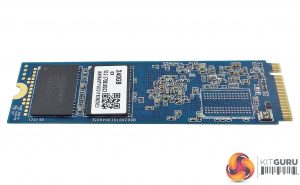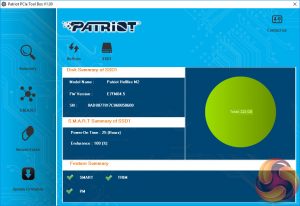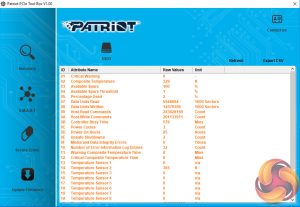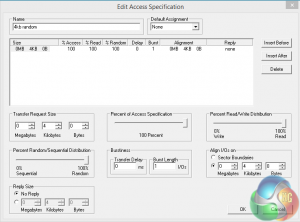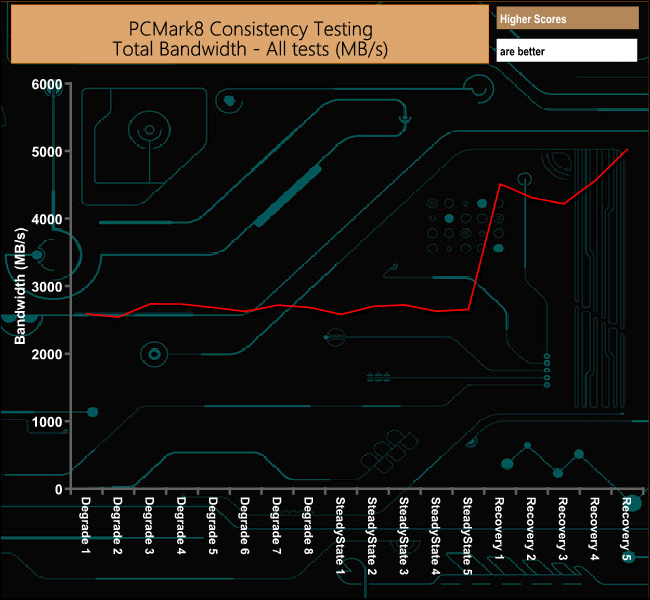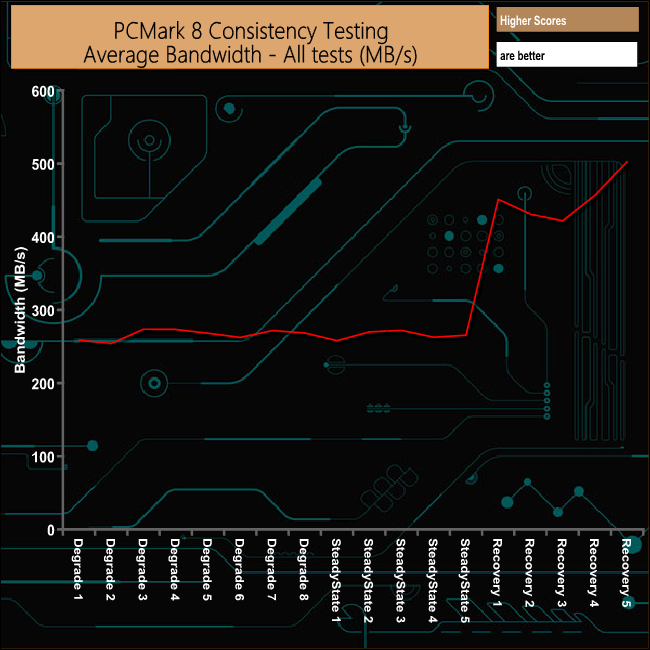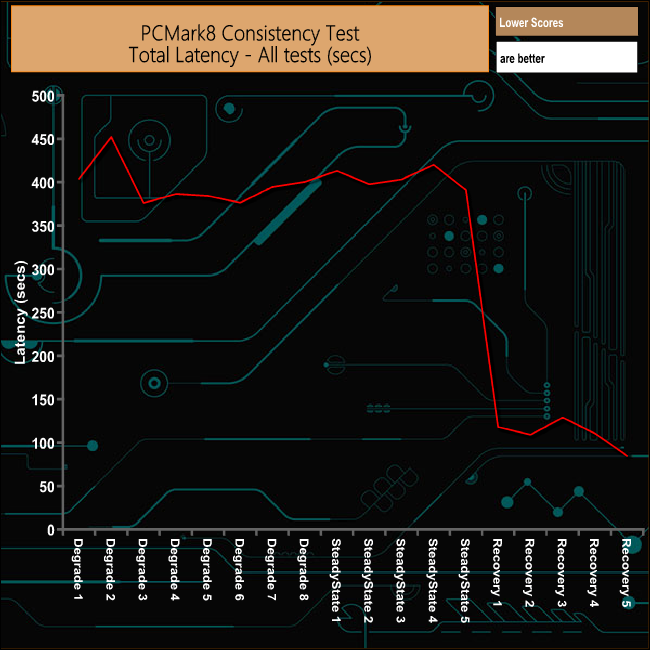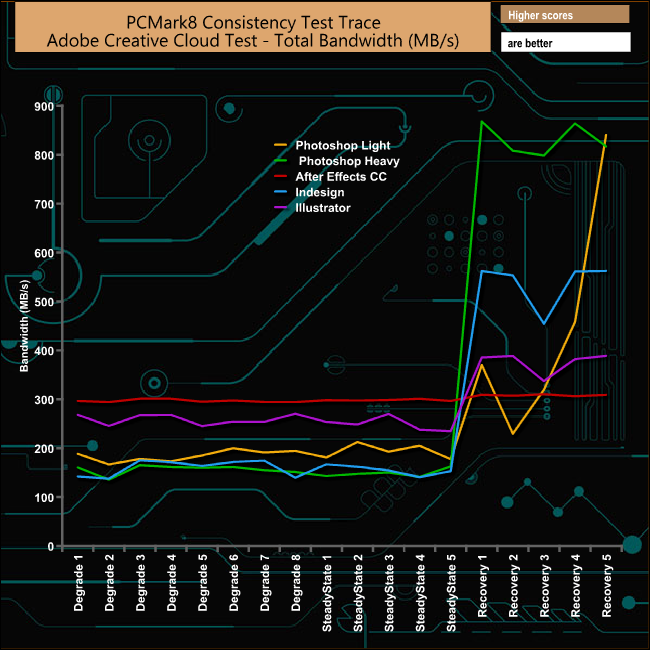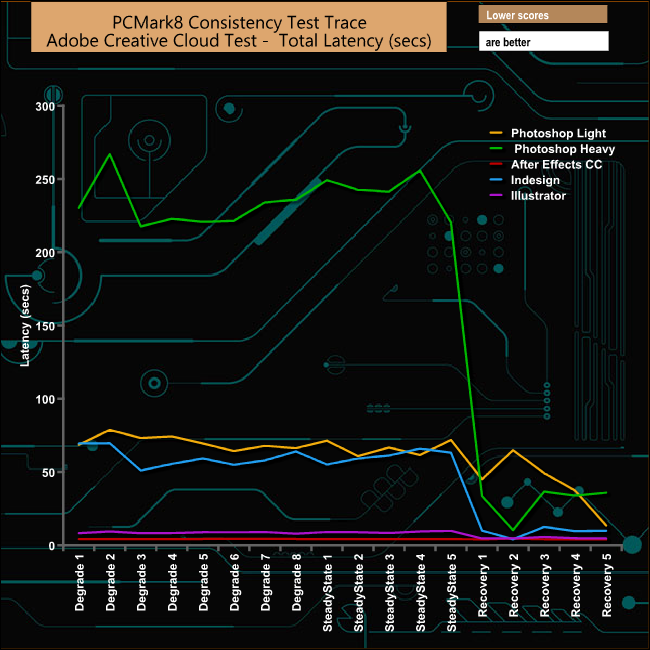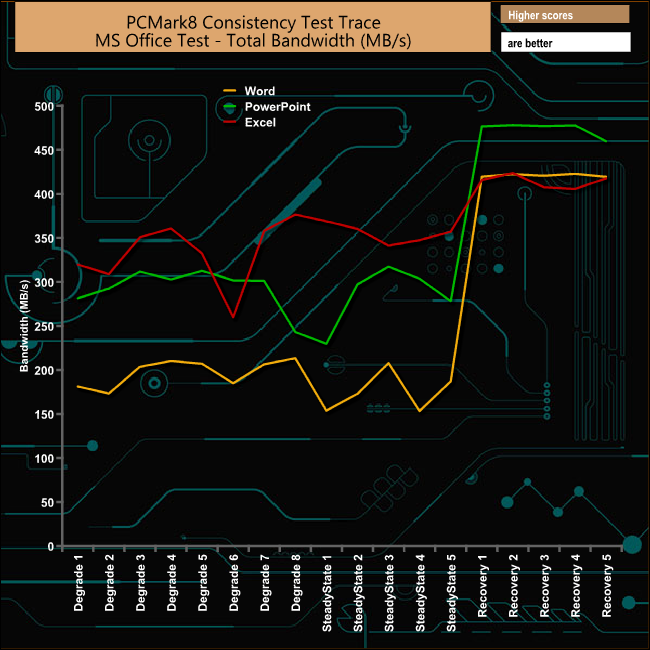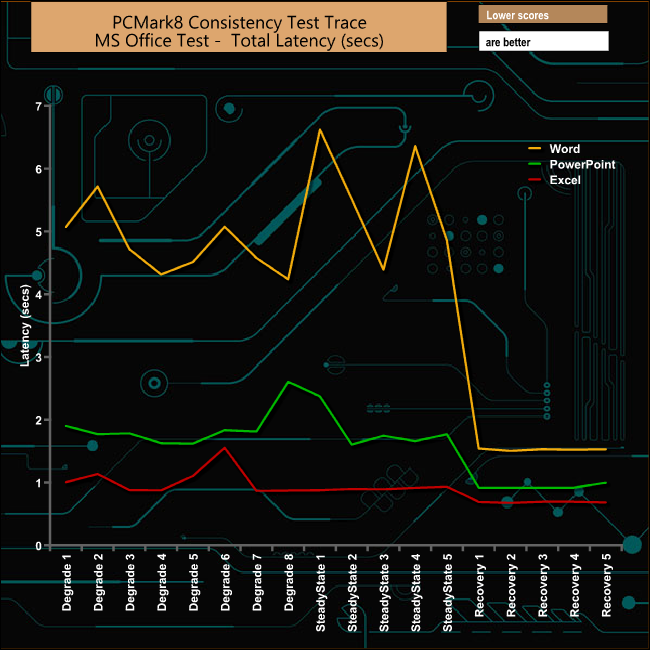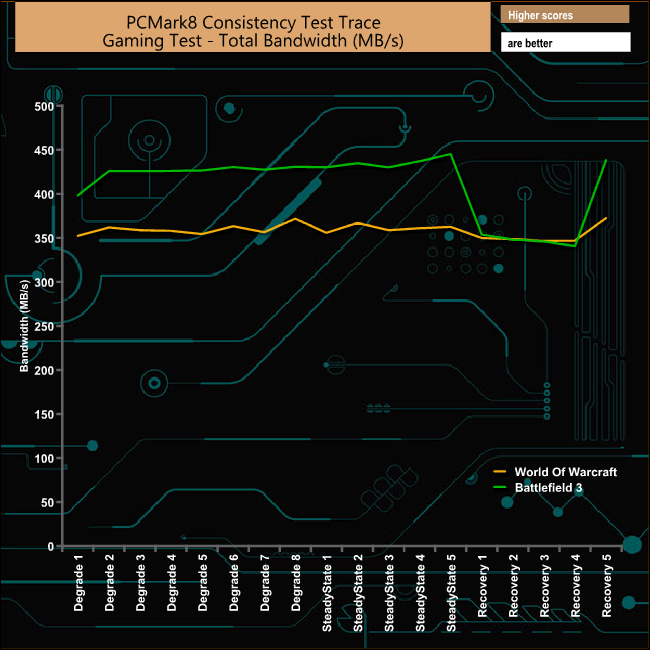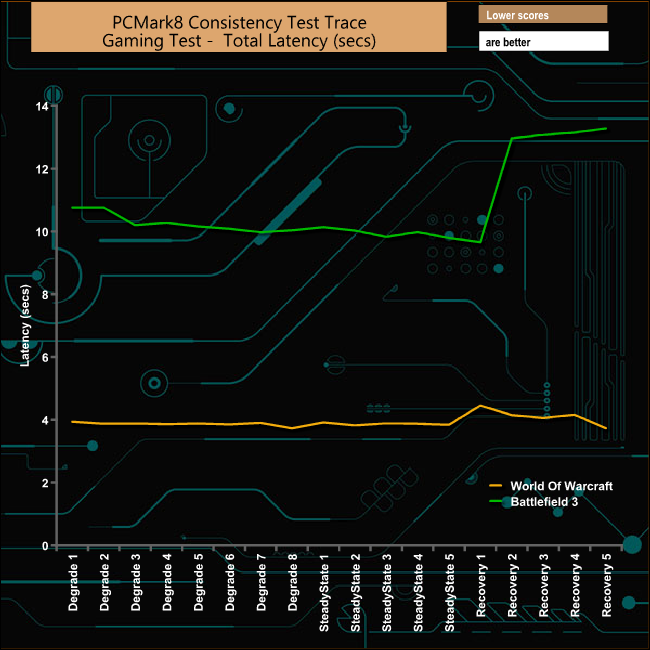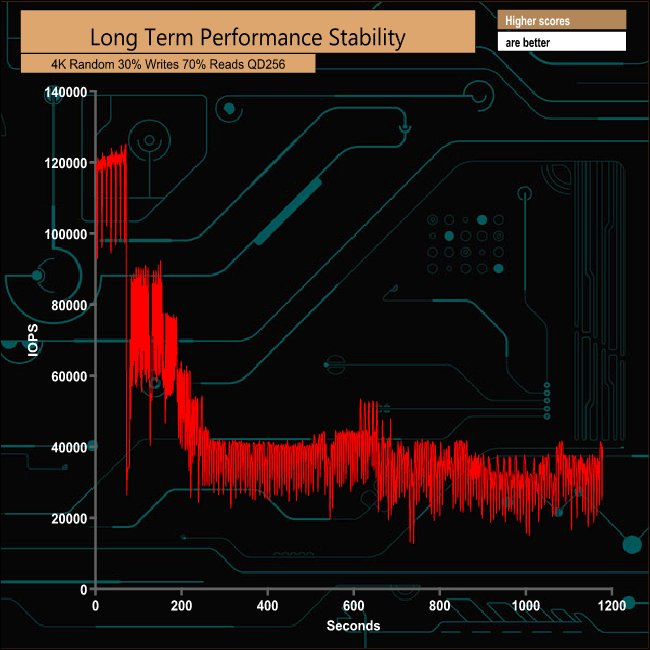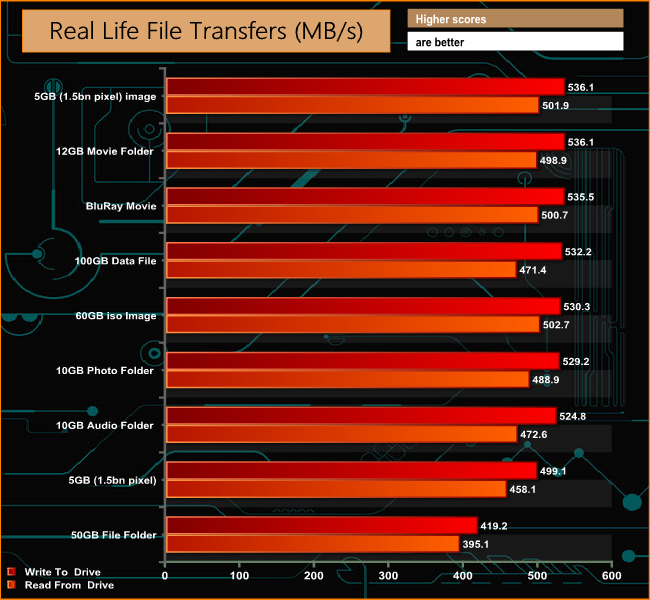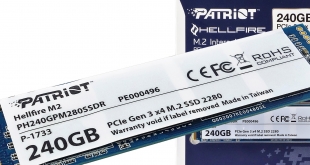
Patriot's Hellfire M.2 SSD, the company's first NVMe drive, is built on a 2280 format with a PCIe 3.0 x4 interface. It uses a combination of a Phison PS5007-E7 controller and 2D MLC NAND.
Patriot's Hellfire SSD comes in two capacities, 240GB and the flagship 480GB. The drives use a combination of an 8-Channel Phison PS5007-E7 controller and Tosihiba 15nm MLC NAND memory. The 240GB drive has 256MB of DDR3L cache with the 480GB drive being equipped with 512MB.
The official performance figures for the 240GB drive are; up to 3,000MB/s for Sequential reads and up to 2,300MB for writes. Random 4K performance is quoted as 170,000 IOPS for reads and up to 185,000 IOPS for writes.
The endurance for the 240GB drive is quoted as 175TBW (the 480GB drive is rated 350TBW) and Patriot back the drive with a 3-yr warranty.
Physical Specifications:
Usable Capacities: 240GB, 480GB
NAND Components: Toshiba 15nm MLC
NAND Controller: Phison PS5007-E7
Cache: 256MB of DDR3L
Interface: PCI-e Gen3.0 x4 NVMe
Form Factor: M.2
Dimensions: 22 x 80 x 3.8mm
Drive Weight: 9g
Firmware Version: E7FM04.5
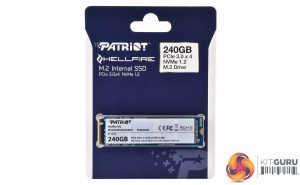
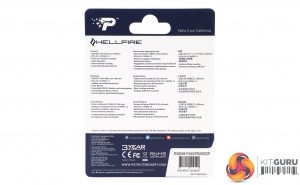
Patriot's Hellfire comes in a simple no frills blister pack with a panel on the front of the pack displaying drive capacity and interface details. The rear of the pack displays brief multilingual descriptions of the drives features.
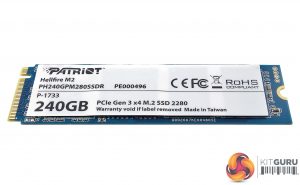
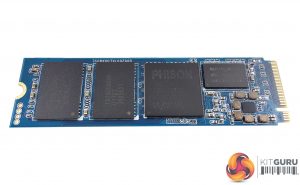
The front side of the PCB has all the components hidden under a sticker. Once removed the main contents of the drive are revealed, there are two Toshiba 15mn 64GB MLC NAND packages (labelled TA79G5NAUR), a Phison PS5007-E7 controller and a 256MB DDR3L-1600 cache IC (Nanya NT5CC128M161P). Another two 64GB NAND packages are housed on the reverse side of the PCB.
The 8-channel PS5007-E7 uses a quad core CPU and is Phison’s first NVMe controller. It has a PCIe Gen 3.0 x 4 interface and supports 1z nm MLC, TLC and 3D NAND and has a feature set that includes SmartECC, SmartRefresh and SmartFlush technologies.
SmartECC reconstructs faulty pages due to ECC failures, SmartRefresh monitors ECC health status and refreshes ECC blocks periodically which improves data retention and SmartFlush cuts down the amount of time any data is spent in cache which helps to ensure maximum data retention should the drive suffer a power loss.
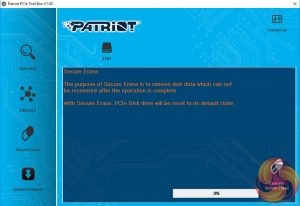
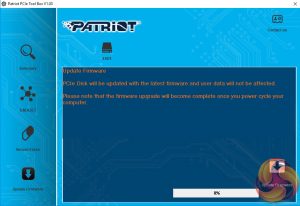
Patriot's SSD management software, the Patriot PCIe Tool Box (v1.00) looks a pretty basic utility compared to some of it competitors offerings but it really does offer all you really need to keep an eye on your drive.
It shows information on firmware version, serial number, total capacity and the power-on time, if TRIM is enabled and SMART data. It also allows the secure erase of the drive and updating of the drives firmware.
For testing, the drives are all wiped and reset to factory settings by HDDerase V4. We try to use free or easily available programs and some real world testing so you can compare our findings against your own system.
This is a good way to measure potential upgrade benefits.
Main system:
Intel Core i7-7700K with 16GB of DDR4-3200 RAM, Sapphire R9 390 Nitro and an Asus Prime Z270-A motherboard.
Other drives
Corsair Force MP500 480GB
Corsair Neutron NX500 800GB
Intel Optane Memory 32GB
Kingston HyperX Predator 480GB
Kingston KC1000 960GB
OCZ RevoDrive 350 480GB
OCZ RevoDrive 3 x2 480GB
Plextor M8PeG 512GB
Plextor M6e Black Edition PCIe 256GB
PNY CS2030 240GB
Samsung SSD960 PRO 2TB
Samsung SSD960 EVO 1TB
Samsung SSD950 PRO 256GB
Samsung SM951 256GB
Samsung XP941 512GB
Toshiba OCZ RD400 512GB
Western Digital Black PCIe 512GB
Software:
Atto Disk Benchmark.
CrystalMark 3.0.3.
AS SSD.
IOMeter
All our results were achieved by running each test five times with every configuration this ensures that any glitches are removed from the results. Trim is confirmed as running by typing fsutil behavior query disabledeletenotify into the command line. A response of disabledeletenotify =0 confirms TRIM is active.
CrystalDiskMark is a useful benchmark to measure theoretical performance levels of hard drives and SSD’s. We are using V3.0.3.

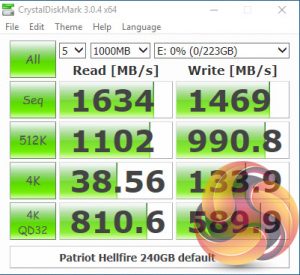
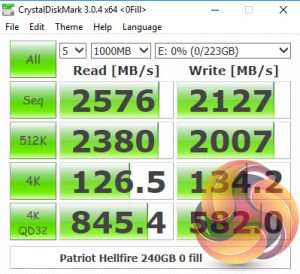
The Phison PS5007-E7 controller has a marked preference for highly compressible data as can be seen by the two benchmark result screens. Sequential read/writes and 4K/512K data reads at shallow depths get a healthy kick up in performance when the drive is tested with the highly compressible data test of CrystalDiskMark.
The ATTO Disk Benchmark performance measurement tool is compatible with Microsoft Windows. Measure your storage systems performance with various transfer sizes and test lengths for reads and writes. Several options are available to customize your performance measurement including queue depth, overlapped I/O and even a comparison mode with the option to run continuously.
Use ATTO Disk Benchmark to test any manufacturers RAID controllers, storage controllers, host adapters, hard drives and SSD drives and notice that ATTO products will consistently provide the highest level of performance to your storage.
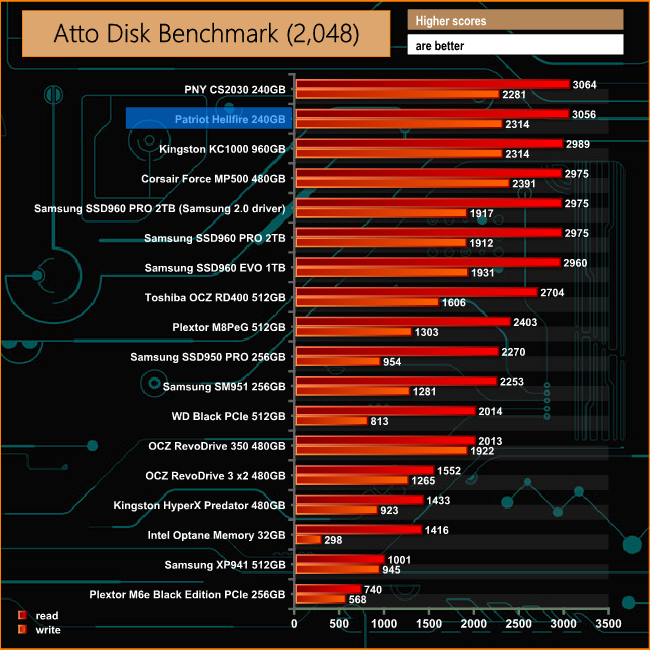
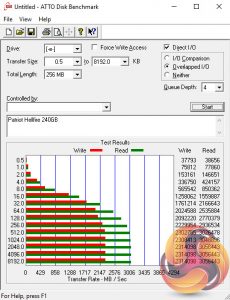
Patriot quote Sequential read/write performance for the 240GB Hellfire as up to 3,000MB/s and 2,300MB respectively. Those figures were confirmed by the ATTO benchmark, the tested drive producing 3,056MB/s for reads and 2,314MB/s for writes, making it a very quick drive.
AS SSD is a great free tool designed just for benching Solid State Drives. It performs an array of sequential read and write tests, as well as random read and write tests with sequential access times over a portion of the drive. AS SSD includes a sub suite of benchmarks with various file pattern algorithms but this is difficult in trying to judge accurate performance figures.
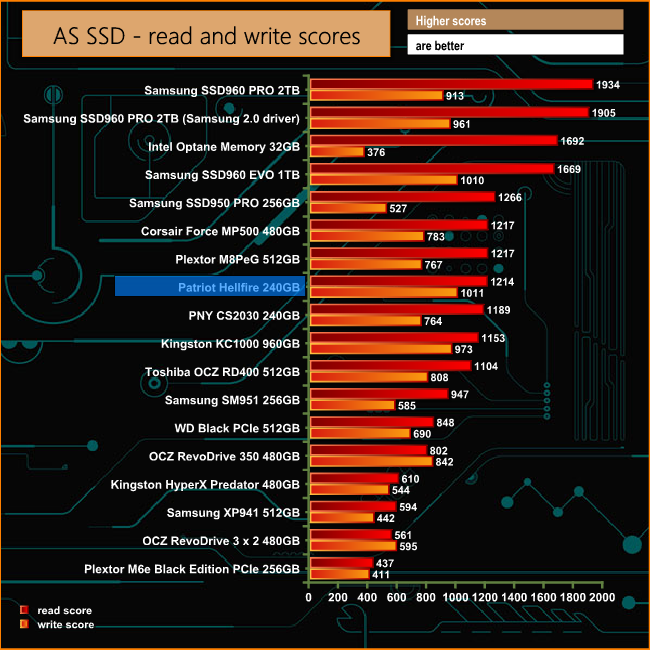
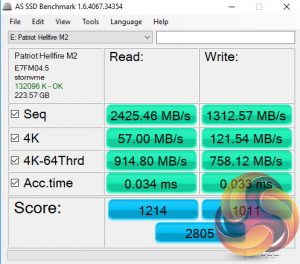
Patriot's Hellfire drive sits between the other two drives we've looked at that uses a Phison PS5007-E7/Tosihiba 15nm MLC combination, Corsair's Force MP500 and PNY's CS2030. Although the read score of the three drives is pretty well matched, the Hellfire out scores both when it comes to writes.
IOMeter is another open source synthetic benchmarking tool which is able to simulate the various loads placed on hard drive and solid state drive technology.
We test with both random read and write 4k tests, as shown above. There are many ways to measure the IOPS performance of a Solid State Drive, so our results will sometimes differ from manufacturer’s quoted ratings. We do test all drives in exactly the same way, so the results are directly comparable.
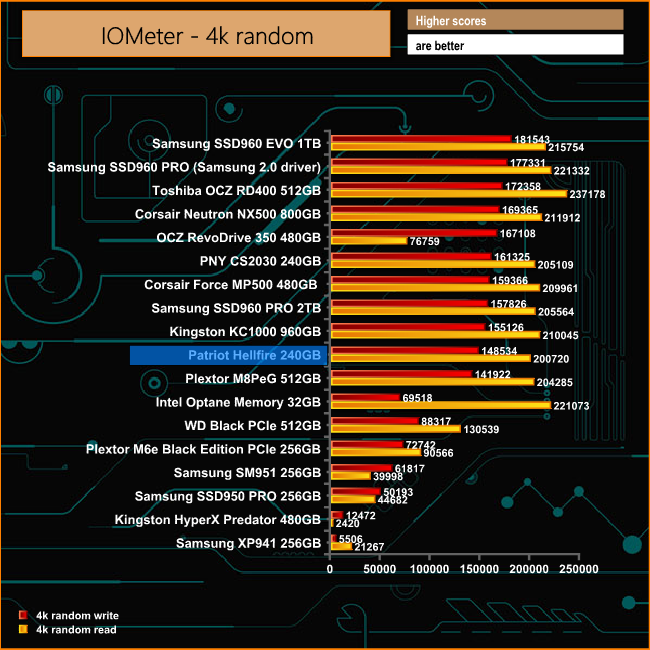
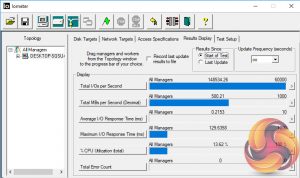
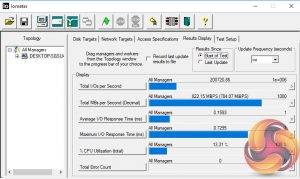
Patriot quote Random 4K read/write performance for the Hellfire of up to 170,000 IOPS and 185,000 IOPS respectively.
With our IOMeter test we couldn't get close to the maximum quoted figure for writes, the tested drive producing 148,534 IOPS but when it came to reads, the drive sailed past the official figure, giving a total of 200,720 IOPS.
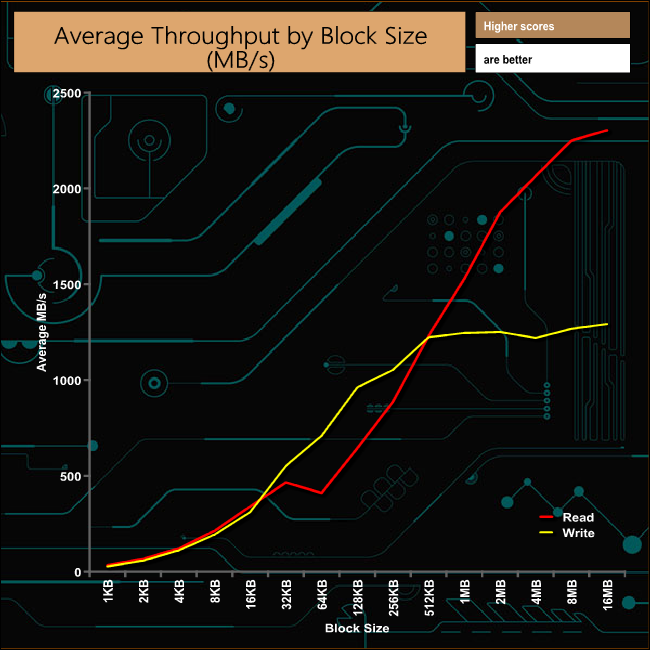
During the throughput test there was a slight dip in read performance at the 64KB block level but the drive recovered well, peaking at 2,303MB/s at the end of the test with writes peaking at 1,291MB/s.
Futuremark’s PCMark 8 is a very good all round system benchmark but it’s Storage Consistency Test takes it to whole new level when testing SSD drives. It runs through four phases; Preconditioning, Degradation, Steady State, Recovery and finally Clean Up. During the Degradation, Steady State and Recovery phases it runs performance tests using the 10 software programs that form the backbone of PCMark 8; Adobe After Effects, Illustrator, InDesign, Photoshop Heavy and Photoshop Light, Microsoft Excel, PowerPoint, Word, Battlefield 3 and World of Warcraft. With some 18 phases of testing, this test can take many hours to run.
Preconditioning
The drive is written sequentially through up to the reported capacity with random data, write size of 256 × 512 = 131,072 bytes. This is done twice.
Degradation
Run writes of random size between 8 × 512 and 2048 × 512 bytes on random offsets for 10 minutes. It then runs a performance test. These two actions are then repeated 8 times and on each pass the duration of random writes is increased by 5 minutes.
Steady State
Run writes of random size between 8 × 512 and 2048 × 512 bytes on random offsets for final duration achieved in degradation phase. A performance test is then run. These actions are then re-run five times.
Recovery
The drive is idled for 5 minutes. Then a performance test is run. These actions are then repeated five times.
Clean Up
The drive is written through sequentially up to the reported capacity with zero data, write size of 256 × 512 = 131,072 bytes.
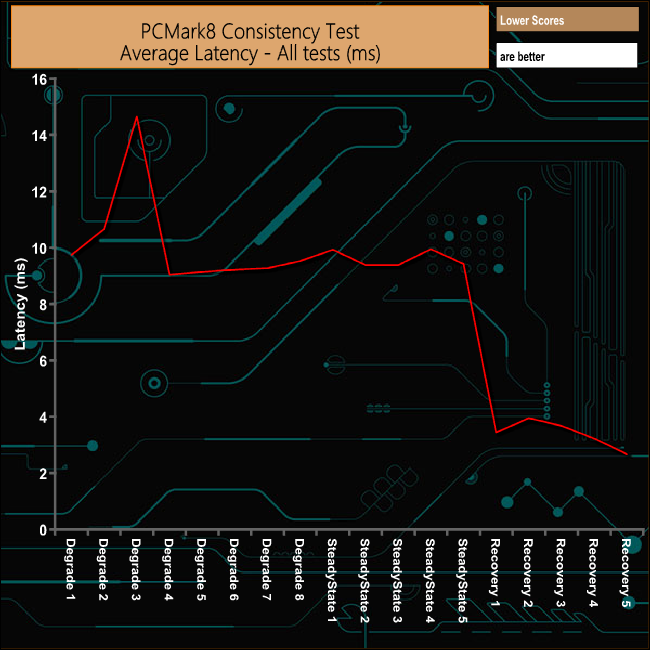
The drives performance took a hit during the second Degradation run but it recovered from that and performed pretty well through the rest of the Degradation and Steady State phases and although it certainly recovers well at the end of the test it's not very consistent through the recovery phases.
PCMark 8’s Consistency test provides a huge amount of performance data, so here we’ve looked a little closer at how the Patriot Hellfire performs in each of the benchmarks test suites.
Adobe Creative Cloud
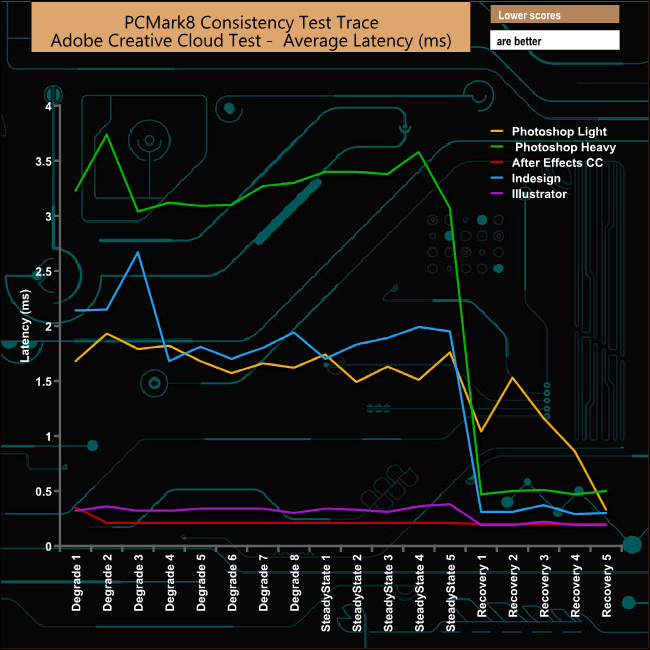
As usual in this benchmark test, the Adobe Photoshop Heavy trace is the one that stresses the drive the most, with the bandwidth dropping to 135MB/s at one point but the Patriot Hellfire recovers from the ordeal very well indeed, with the bandwidth peaking at 863MB/s during the recovery cycle.
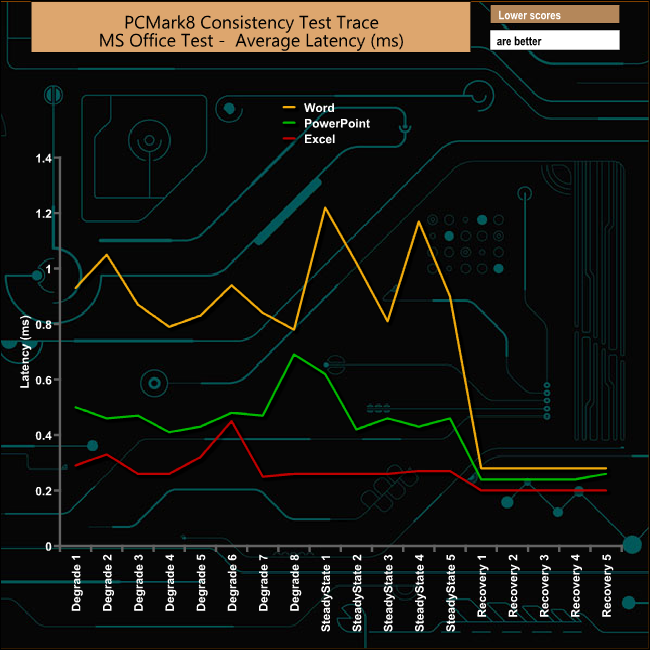
The drive's performance gets hit hard during the test runs with the Word trace. The performance drops as low as 153MB/s during the Steady State runs but the Hellfire recovers extremely well peaking at 422.29MB/s during the Recovery cycle with a very good level of consistency, averaging 420.96MB/s for the five runs.
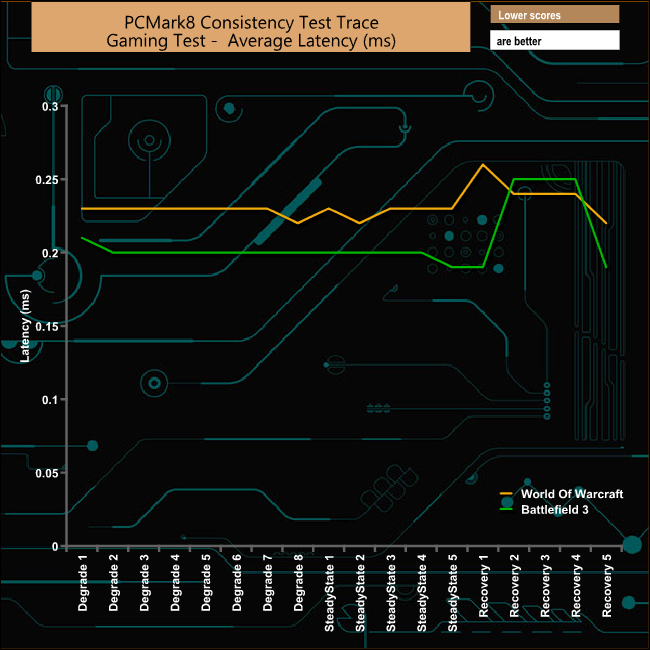
Oddly the only time the drive seems to suffer any real performance loss in the Casual Gaming tests is during the Recovery phase when testing the Battlefield 3 trace, where the bandwidth dropped to 340MB/s at one point. It only starts to pull back the performance on the very last run, recovering back up to 438MB/s.
Just like the Consistency test, PCMark 8’s standard Storage test also saves a large amount of performance data. The default test runs through the test suite of 10 applications three times. Here we show the total bandwidth performance for each of the individual test suites for the third and final benchmark run.
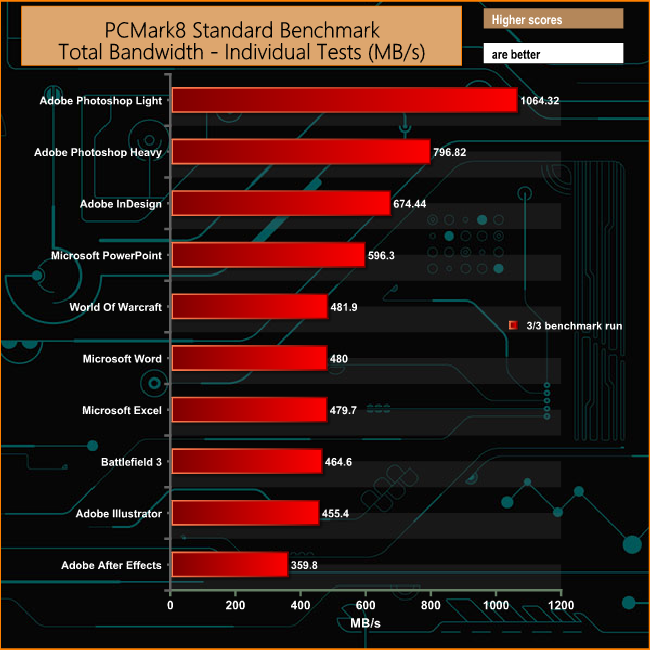
The drive handles all the tests pretty well but the way it deals with the Adobe Photoshop Light test is particularly impressive, with a bandwidth score in the third and final run of the benchmark of 1,064.32MB/s.
For the long term performance stability test, we set the drive up to run a 20-minute 4K random test with a 30% write, 70% read split, at a Queue Depth of 256 over the entire disk. The 240GB Patriot Hellfire averaged 44,613 IOPS for the test with a performance stability of 57%.
To test real life performance of a drive we use a mix of folder/file types and by using the FastCopy utility (which gives a time as well as MB/s result) we record the performance of drive reading from & writing to a 256GB Samsung SSD850 PRO.
100GB data file.
60GB iso image.
60GB Steam folder – 29,521 files.
50GB File folder – 28,523 files.
12GB Movie folder – 24 files (mix of Blu-ray and 4K files).
10GB Photo folder – 621 files (mix of .png, raw and .jpeg images).
10GB Audio folder – 1,483 files (mix of mp3 and .flac files).
5GB (1.5bn pixel) photo.
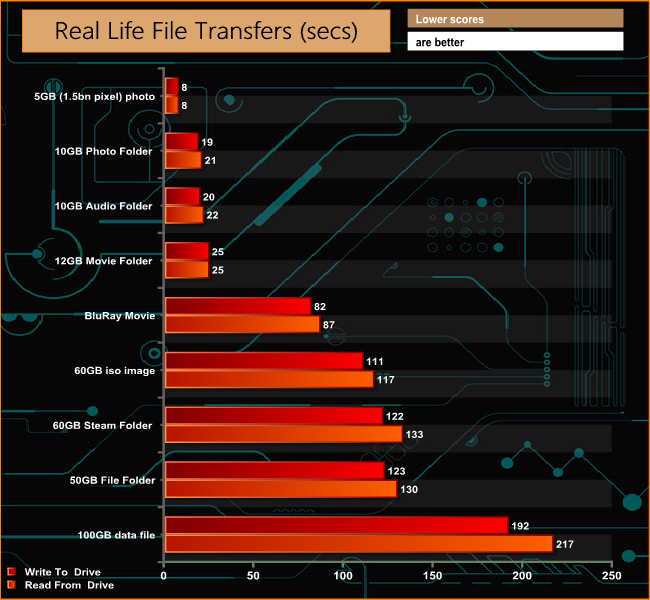
The drives write performance when dealing with our real life file transfer tests is very good, topping 500MB/s for all bar the 50GB File Folder transfer where the write performance drops to just over 400MB/s.
Patriot have a wide portfolio of Flash based drives from memory cards to standard 2.5in SSDs. The one gap in the current product line was a PCIe interfaced drive, a gap that has been more than adequately filled by the Hellfire M.2, the company's first NVMe drive, which has a PCIe Gen3.0 x4 interface.
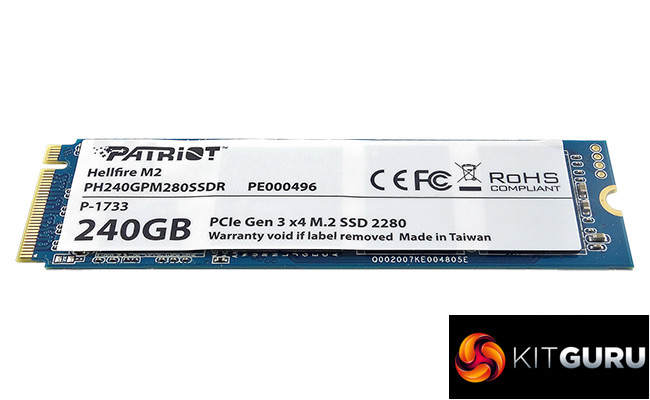
The 240GB Hellfire uses a combination of an 8-Channel Phison PS5007-E7 controller and Toshiba 15nm MLC NAND memory to good effect with quoted Sequential read/write performance figures of 3,000MB/s and 2,300MB respectively. We could confirm those figures using the ATTO benchmark, the tested drive producing 3,056MB/s for reads and 2,314MB/s for writes.
Random 4K read/write performance is quoted as up to 170,000 IOPS for reads and up to 185,000 IOPS for writes. Using our IOMeter test setup we couldn't match the official write figure, the review drive topping out at 148,534 IOPS. On the other hand the drive sailed past the official read figure, producing a score of 200,720 IOPS.
The drive had no problems dealing with our real life data transfer tests, topping 500MB/s for writes on all tests bar the 50GB File folder transfer where the write performance drops to just over 400MB/s while read averaged out at 476.7MB/s for all nine tests. Once again dealing with the small bity files of the 50GB File folder caused the drive to stumble a little bit with the read performance dropping to 395.1MB/s.
The endurance for the 240GB drive is quoted as 175TBW (the 480GB drive is rated 350TBW) which works out at around 159GB of writes per day over the 3-yr warranty that Patriot back the drive with.
Patriot's SSD management software, the Patriot PCIe Tool Box (v1.00) looks a bit basic compared to some of its flashier competitors but the basic functions are all included with one notable exception. It shows information on firmware version, serial number, total capacity and the power-on time, if TRIM is enabled and SMART data. It also allows the secure erase of the drive and updating of the drives firmware. The one thing missing is any form of drive cloning utility, which fingers crossed, may be included in later versions of the Tool Box.
We found the 240GB version of the Patriot Hellfire for £102.90 (inc VAT) at alza.co.uk HERE
Discuss on our Facebook page, over HERE
Pros
- Overall Performance.
- Price.
Cons
- 4K write performance a little down in some of our tests.
- SDD Management software lacks a disk cloning option.
Kitguru says: Although Patriot's fast performing Hellfire drive has been around for a while it's still a very capable drive. In an ever increasingly competitive market segment Patriot have given the drive a fighting chance with an aggressive price point.
Be sure to check out our sponsors store EKWB here
 KitGuru KitGuru.net – Tech News | Hardware News | Hardware Reviews | IOS | Mobile | Gaming | Graphics Cards
KitGuru KitGuru.net – Tech News | Hardware News | Hardware Reviews | IOS | Mobile | Gaming | Graphics Cards


